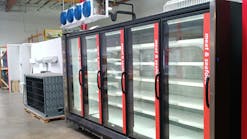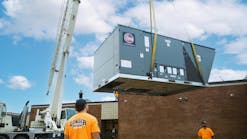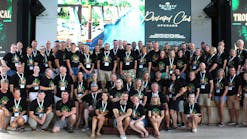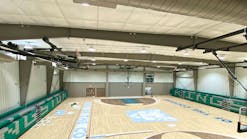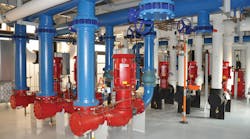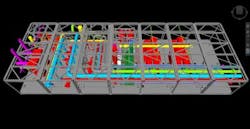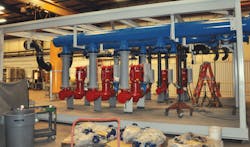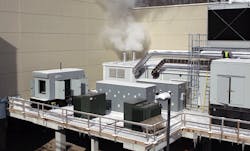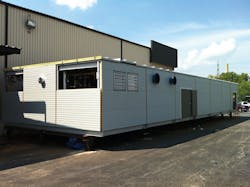That’s exactly what Murphy Company, St. Louis, MO, did on its Design/Build award-winning project at Belterra Park Gaming & Entertainment Center in Cincinnati, Ohio. Owner Pinnacle Entertainment tasked Murphy with designing, building, shipping and installing a prefabricated central utility plant for Belterra’s 200,000 sq. ft. casino addition. The mechanical plant provides heating, cooling and domestic water for the addition.
“It’s definitely outside the box thinking,” said Matt Gildehaus, the design engineer in charge of the project. “It’s something mechanical contractors don’t typically do. We stepped out on a limb on this one.”
The project entailed building an 84-foot by 30-foot central utility plant that was built in St. Louis, broke apart and shipped to the job site in eight pieces. The equipment list comprised two boilers, five primary heating hot water pumps, three chilled water pumps, a cooling tower water filter, three condenser water pumps, two cooling towers, two 500-ton water chillers, a chilled water expansion tank, a chilled water Spirotherm AS, a free cooling heat exchanger, two fan coil units, a ventilation fan and exterior louver. The total weight of all the equipment was 230,000.
We do skids all the time, but on a smaller scale,” Gildehaus said. “The difference with this one is it had a roof, it had walls, it had to meet building codes. There’s a lot more that went into this one than what we’ve done in the past.”
Roadblocks
The first issue Murphy Co. had to overcome was its physical location.
“We had the space,” Gildehaus said. “What we didn’t have was a level surface. We had to build a steel platform that was big enough to set the entire plant on." The level steel frame, which was built in Murphy Co.’s yard, had steel walls and a roof to facilitate work on the CUP. Murphy was awarded the project on May 1, 2013, work on the steel modules began on June 1, and the pieces were shipped on Sept. 9.
The second issue Murphy overcame was a major change by Pinnacle to the boiler plant. The original plan called for one boiler with one future boiler.
“After we actually started working on the project, had all the steel fabricated and finished, they requested we go to two boilers with a future third,” Gildehaus said. “It required a whole new layout that we had to do on the steel platform that was already fabricated and sitting in our warehouse.
“We were able to meet all that, change the layout and still get it to the jobsite on time.”
Murphy was able to adjust in part because the Belterra project was the only project the company worked on during that time frame, according to Gildehaus.
Gildehaus said shipping the pieces of the CUP to Cincinnati required the services of several shipping companies to find the necessary number of lowboy trailers, which were the only option for transport. Seven of the skids were 12 feet by 30 feet, and one piece was 35 feet by 8 feet.
Winner at a Glance:
Company: Murphy Company, St. Louis, MO
Project Name/Location: Belterra Park Gaming & Entertainment Center, Cincinnati, OH
HVAC Cost: $2.6 million
General contractor: Yates/Paric, St. Louis, MO
Products Key to Success:
• Armstrong primary heating hot water pumps, condenser water pumps, expansion tanks, free cooling heat exchanger
• Camus hydronic heating boilers
• Greenheck ventilation fan, exterior louver
• Lakos cooling tower filtration systems
• Marley cooling tower cells
• Spirotherm chilled water separators
• Trane fan coil units
• Trane CenTraVac chillers
Murphy Company Team:
• Matt Gildehaus, P.E., design engineer
• Gary Hackel, VP operations
• Gary DeFosset, project manager
• Scott Wright, project foreman
“The biggest challenge was maintaining the dimensions of each skid to where they were shippable and we could still get permits to ship them,” he said. “At the same time we were doing that, we were making sure the interior was still maintenance friendly, all the equipment clearances were met and they could be accessible and be maintained in a good manner.”
The first delivery trip was four skids, and then those trucks returned and picked up the second round of skids. The trip to Cincinnati took two days per trip.
“We had a crane waiting for the trailers,” Gildehaus said. “As the first section arrived, we picked it up, sat it where it needed to go and so forth. The sequence worked out well.”
Gildehaus said it took about two months after delivery to hook everything up and then start and test the equipment.
One more large issue popped up when the pieces were onsite and constructed.
“Where our chiller plant is located relative to the casino, it’s required to be fireproof, similar to the casino,” Gildehaus said. “It was a surprise to the whole team. It wasn’t in the original (request for proposal) package we had bid on.”
That issue had to be resolved on site after the CUP was assembled.
“We had to have a local contractor fireproof the steel and the roof,” Gildehaus said. “They had to match the construction of the adjacent casino, so we had a one-hour roof and two-hour structure fireproofing requirement. After it was all assembled, all the piping was done and everything was started up we had to have the contractor come in and fireproof it.”
Nuts and Bolts
Gildehaus said that quality was behind the decision to have Murphy handle this project.
“These chiller plants are offered by an equipment manufacturer but the quality of our plant is superior to those,” Gildehaus said. “The steel frame all the way up through the piping, the welds and the layouts. For being the first one we have done, it went together like we thought it would.”
Another reason? Timeliness.
“We tried to meet all the owner requests without affecting the ship date,” he said. “It got a little tight at times and we know that a vendor-provided plant would not have done that. They would have requested so many more weeks of fabrication time before delivery.”
Handling the project remotely presented tremendous economies of scale, provided better quality control, and reduced the amount of manpower and cost. There also weren’t the typical challenges of site restrictions or working around the schedules of other contractors.
Building information modeling assisted Murphy to determine the best configuration for the large amount of equipment in the CUP, and allowed the company to show the client 3D models as design and construction progressed.
American Society of Heating, Refrigerating, and Air-conditioning Engineers (ASHRAE) and National Environmental Balancing Bureau (NEBB) standards were followed throughout the entire
project. The RFP specified what brands of equipment should be installed.
Gildehaus said Murphy is proud of its involvement in the Belterra CUP project.
“There was a lot of work that went into it,” he said. “It definitely wasn’t the easiest project we’ve ever worked on but it’s a very rewarding one. “It opened the door for future endeavors now. We know we can do it.”
Congratulations to the team at Murphy Company! As a repeat Design/Build Award winner, you’ve again shown what can be accomplished with careful planning, diligent follow-through, and a commitment to excellence.





